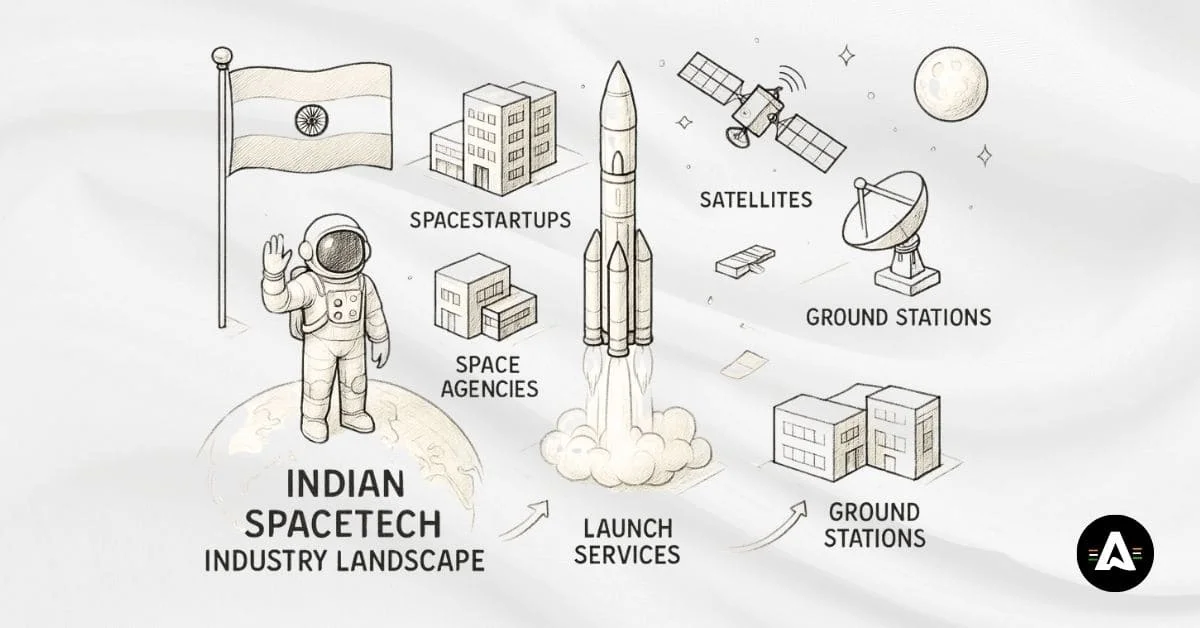Business Model Template for Space Tech Startups

Explore key ideas to help build strong business model template for space tech ventures. Learn smart ways to use advancements in satellite data and low Earth orbit tech in the business.
Get to know about India’s growing space sector. The Indian government is now bringing in new steps to support it, like giving incentives to private businesses and making FDI rules easier.
Find out how to build business model canvases that match with global coverage goals and what the market really needs.
See the different ways businesses can make money and use fresh ideas to sell their products in the larger space economy.
Look at some big challenges, like high capital needs and tech gaps. Get tips and ideas on how to solve these problems.
Introduction
The space industry is full of new ideas. Right now, there are big chances for people and startups in space technology and spacecraft. To make it in this field, you need to have a good business model. A clear plan will help you deal with hard times and use the growing demand for satellite data and for world-wide connections.
This article is here for you. It shares good plans and tips made for those working in spacetech and in the space industry. If you want to work on space missions, build new business models, or move spacecraft work ahead, you will find this a good starting point.
Understanding the Space Tech Startup Landscape in India
India’s spacetech sector is growing fast. A lot more people now start new tech businesses in this area. The Indian government gives a lot of help, letting private companies take part in things like satellite technology and low earth orbit missions since 2020. With groups like New Space India Ltd (NSIL) and more money in the budget, people in India have good chances to work on new space tech ideas.

There is also help from things like GST breaks and easier rules when it comes to foreign direct investment. There are strong ties with ISRO and Indian National Space Promotion. All these help new startups to grow. India wants the space economy to reach $44 billion by 2030. With these changes, there are now many good chances for people and companies who want to be part of this.
Key Market Trends and Growth Drivers
Startups in the space tech world are growing because more people now want exact earth observation and better satellite data. With the rise of IoT and internet uses, more businesses use satellites for things like keeping an eye on our climate, dealing with space debris, and helping farming. This change makes people look for new and affordable tech. There are also more different satellite space missions now as they try to meet the needs of many.
One big reason to change is to give the world better internet. With small satellites, people and businesses can now get better info. It does not cost as much as before. When you add AI and machine learning to these space systems, the data is more useful for everyone. This can help many people and companies all over the globe.
At the same time, there are new advancements in reusable rockets that SpaceX is working on. These make things more affordable and help with sustainability. When you add new ways to build space infrastructure and more trips into low earth orbit, there is nowa good market for people working on things like logistics, better connection, and better ways to get clear satellite imagery.
Regulatory Environment and Key Stakeholders
The Indian government is helping the space sector in India get better. Groups like the Indian Space Research Organisation (ISRO) and IN-SPACe are leading this change. Over the last year, they gave support with money and shared their technical knowledge. These groups also made new rules. This work helped the space sector and satellite technology grow in India.
Programs like NSIL and tax breaks, such as GST exemptions, help private companies in India make new things in spacetech. IN-SPACe has helped over 100 businesses in the space sector. It has also made big tech deals with partners around the world. This shows that India is serious about growing its tech and space sector.
Startups have to know the rules when they work with groups like ISRO, the Department of Space (DOS), and partners from other countries. If you want to launch satellites or do anything new in space operations, you need to follow these rules. The system of rules is important for the space sector to get better in india. It also gives more people a way to get into spacetech.
Core Components of a Space Tech Business Model
To build a strong business model for spacetech ventures, you have to come up with new ideas and fix unique problems. You need to know what your customers want and find more than one way to make money with the business model canvas. It’s also important to set up systems that can grow as your satellite services get bigger.

By using tools like the business model canvas, a startup can make clear plans to grow in the space economy. This tool lets people look at their business model, create new business models, or make changes to what they have now. A good business model helps a company use its people, tech, resources, and partnerships in a way that fits well with the needs of the new space economy.
Unique Value Propositions for Space Startups
In spacetech, having a strong value proposition makes a startup stand out from the rest. This is how it works:
- Satellites offer global coverage. They use several types of sensors to give real-time pictures of the world. People in agriculture, logistics, and disaster management use these pictures a lot.
- You get better precision with earth observation and machine learning. This mix gives us very accurate analytics. It is important for those in finance, urban planning, and more.
- AI is used to get more from satellite data. With AI, it is possible to build good predictive models. These are very helpful for areas that use satellite data.
- There are easy-to-use platforms, like satellite-based apps, that help people process information quickly. This is useful for both businesses and the government.
When startups pay attention to what customers need, they get chosen more often. This helps them stay strong in the market.
Customer Segments and Target Markets
Finding the right group of customers is important when you want a spacetech business to grow fast. The table below shows the main markets.
Customer Segments | Description |
|---|---|
Government Agencies | Use satellite imagery for looking after safety and handling disaster recovery. |
Industry Leaders | Get analytics from space technology to work better in farming and plan their resources. |
Tech Automation Firms | Build business models that use machine learning with space tech. |
Small Enterprises | Use affordable satellite data to keep track of their stuff. |
Different groups, like the ones working on space missions or looking at climate, often need services that use space technology. This means there is always demand for satellite data, satellite imagery, and other services that come from space missions. It keeps things steady for those who work in these areas.
Revenue Streams for Space Tech & Aerospace Ventures
Spacetech ventures make money in a few ways. They can get it by selling satellite services to people or other companies. They also use different pricing models for this. This is how the spacetech field builds several revenue streams.
Some usual ways they make money include asking people or companies to pay each month for tools that give them satellite imagery. They also charge for ways to look at that data and for analysis. There are pay-as-you-go options for work that needs a lot of precision. A lot of what they earn also comes from commercialisation of space infrastructure.
To get more income, they have special pricing plans. These plans are made to fit what people want most and what the market is looking for now. As the space economy grows, more people want flexible ways to pay. These new ways work better for needs that may be special or smaller than usual.
Commercialization Strategies
Good commercialization is what makes spacetech stand out. Startups can get money from satellite imagery by offering pay-per-use apps. These services help a lot in areas like urban planning and logistics. When you build tools with machine learning, businesses that want new things are more likely to use them.
Sending up smaller satellites helps the work get done faster and run more smoothly. It also lets many small groups use space services. Before, these services would cost too much for them. Now, they have a good chance to get what they need.
When you work with others on space missions, make launch-ready tools, and turn data into products you can sell, you help make sure the money keeps coming in. The field of space missions needs sustainability. You also have to be exact and quick to change when needed. All these things are very important in this kind of work.
Government and Private Sector Opportunities
There is still a lot you can do when the Indian government and private companies help each other. Here are the main chances you should see:
- Space economy incentives: With help from NSIL, these platforms make it easier for people and businesses to use space infrastructure. This helps the space economy grow.
- Launchpad partnerships: These partnerships open up more ways for people to reach low Earth orbit. You can launch satellites with less trouble and earn money faster.
- FDI participation: When the rules for outside investors become looser, it helps the space sector. Now, more people from across the world can take part in space operations and help them run better.
- Private collaborations: By working together with startups that know a lot about propulsion, green tech, and logistics, people can make big progress. These private partnerships push tech forward and help the space field move faster.
When new companies follow the rules set by the government and work with private partners, they can grow bigger and faster. This way, they get help from both the government and private groups. It also makes it easier for them to reach more people and do better in the market. Over time, this can help them get more trust from customers and grow their business in a good way.
Downloadable Business Model Canvas Template
The business model canvas can be a good tool for any spacetech startup. It helps you look at, plan, and grow your business in a way that is simple and clear. You can find a business model canvas template that is made for startups. This can make it easier to start your own business in spacetech.
This all-in-one guide is here to help you handle your resources and link your tasks together. It will help you find new business models and work with top partners. The guide also helps you add extra ways to make money and keep your users’ needs at the center of your work.
Click the link below to get your own business model canvas template. It is a good first step if you want to grow in space tech. A business model canvas can help you see your tech ideas in a clear way. This business model is useful for anyone looking to get started or move ahead in this field.
How to Use the Canvas for Your Space Tech Startup
Using the business model canvas makes it easier for you to make clear and fast choices. First, look at your customer segments. Think about what people need the most when it comes to satellite data analytics. This step is an important part of setting up your space technology plan and building your business model.
Next, you need to connect your unique value propositions with the market. This could be by offering global imaging services, or by using precision apps made for specific groups. Doing this helps you to reach the right niche and pick the best way for your business.
Keep working on your canvas as you go. This helps your business model grow and change with time. It lets you handle new space missions. You can also send out satellites in the right way, and go after markets in the fast-growing space sector. This tool gives you more flexibility than any other.
Tips for Customizing the Template for Indian Market Needs
If you change the business model canvas to fit the Indian market, your business model may work better. There are some easy steps you can take:
- Use the strong infrastructure in Bengaluru and Chennai. This can help keep the manufacturing costs low.
- Make sure your pricing strategies work well for what people in farming and industry need.
- Work with IN-SPACe, so you can get help with rules and also move up with new technology faster.
- Give flexible services for satellite deployment that meet what rural development projects need.
Customisation helps your business stay right for the special needs and challenges in India.
Common Challenges and Solutions in Building a Space Tech Business Model
Spacetech startups, like those working in the aerospace area, often have big problems. They may need a lot of money to keep going. Sometimes, they do not have enough experience with satellite technology. To get through these tough times, many of them search for the right partners. They also try to bring in smart investors, like Google, who think the future will be bright for spacetech.
Working on better sustainability is very important for spacetech companies. They are coming up with new ways to use propulsion systems and robotics. This helps their work a lot. When they focus on fixing market gaps with precision, they can still grow as a company. There are many roadblocks, but they can get past them by using new technology and by working together.
Navigating High Capital Requirements
Getting money for space missions can be tough. But you can get past these problems by trying many ways. Here are some things you can do:
- Look for funding from programs like the NSIL-backed government VC plans.
- Work on building reusable propulsion systems. This can help lower the cost over time.
- Work together with global investors who want projects that can get bigger and do better in a steady way.
If you spend less at first and work with other countries, you help to make sure that your business can keep going. This way, you give your business a better chance to do well for a long time. Working with others can also help you get new ideas and reach more people.
Addressing Technological and Talent Gaps
India’s space industry is having problems because there are not many people with skills in AI, robotics, and satellite systems. Tech startups in India can help with this by finding workers from other areas and giving them good training. This way, the space industry can get more people to work with AI and robotics. It will also help the tech field grow in India.
Work with ISRO and learning centers to get special knowledge. Use machine learning tools and data analytics for satellites. This will help fill tech gaps faster and better. Use the best of tech to move ahead.
Take ideas from different fields to help improve technical skills. This is important to bridge gaps in the space industry in India. It also helps to make new ideas and progress possible.
Conclusion
To sum up, starting a job in the space technology or space tech startup world needs you to have a strong business model. You will want this business model to fit both changes and challenges that come with working in space tech. If you know about market trends, your target customers, and where your money will come from, you can help your startup do well in this field. You can use the business model canvas template that is ready to download. This template will help you build a plan that works for the Indian market. Be ready to face every challenge, and use the tips in this guide to build a good plan for your tech startup. A strong plan will help your idea grow and bring new things to space technology.
Frequently Asked Questions
Key parts of the business model are giving a strong value for what you offer and making space missions the main focus. You also need to know where, how, and when your money comes in, and to use data analytics to help make better decisions. It is good to use your resources in the best way you can. You should make solutions that fit what the customers want. If you do this, you give better services. When you use new ideas and set good prices, you help your business go forward year after year.
Start by doing market research to know what’s happening with the prices of satellite data. Make sure you match different pricing models to what customers need in areas like logistics, farming, and commercial machines. When you give services that meet what each customer wants and offer flexible ways to pay, you help your business make steady money.
The Indian government plays a big part in helping the space sector in India. Groups like ISRO, NSIL, and IN-SPACe give a lot of support. There are also policies that make foreign investment easier for spacetech companies and give GST exemptions. The Indian government is open to working with companies from outside India. Because of these steps, the space sector in India is growing. These efforts bring new ideas and help India improve in technology.
Make a good impression on investors with a clear pitch. Talk about how your space technology can grow and meet the need for satellite data around the world. Tell them why you need funding and what you will use it for. Explain the technical parts, like your propulsion system, so they can see what sets your idea apart. Show how your work helps shape the new space economy. Let the investors know you want to work with them so your idea can get to the next level.
Use the link to get in touch with us to get your business model canvas template. We offer free tools to plan a business model that you can change to fit what you need. The template works really well for spacetech companies.




